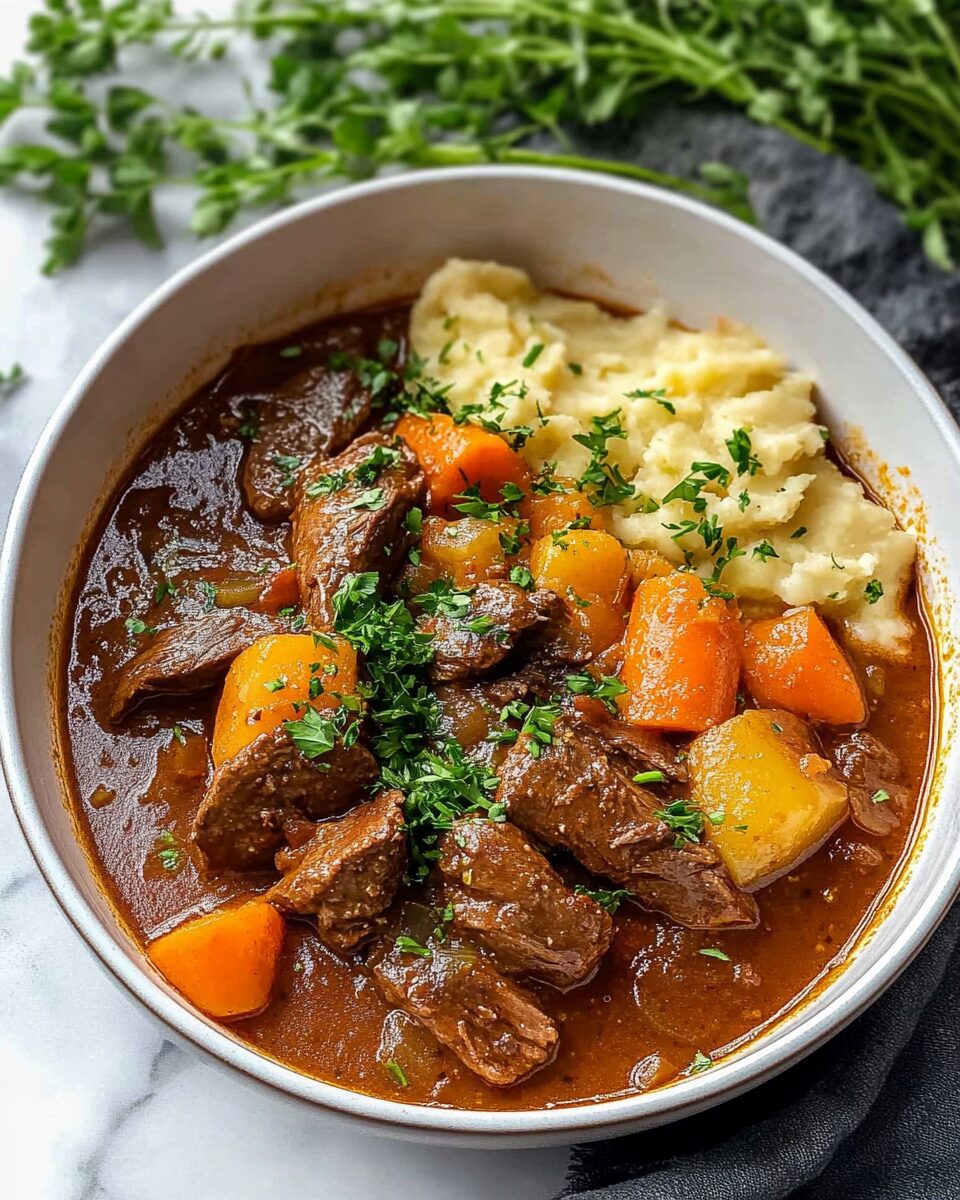This Venison Stew is the ultimate comfort food, with tender venison, earthy root vegetables, and a rich, savory broth that’s perfect for cozy nights. The combination of slow-cooked ingredients creates a depth of flavor that makes each bite a satisfying experience.
The dish is not only delicious but also versatile. You can adjust the vegetables to suit your taste, or substitute the venison with another cut of meat. This stew is perfect for winter meals, family gatherings, or a hearty dinner after a long day outdoors. Serve it with warm crusty bread for a complete meal that will leave everyone asking for seconds.
Full Recipe:
- 2 lbs venison stew meat, cut into chunks
- 3 tablespoons olive oil
- 1 large onion, chopped
- 3 cloves garlic, minced
- 4 carrots, peeled and sliced
- 3 parsnips, peeled and sliced
- 2 large potatoes, peeled and cubed
- 1 cup red wine
- 4 cups beef broth
- 2 bay leaves
- 1 teaspoon thyme
- Salt and pepper to taste
- Fresh parsley, chopped (for garnish)
Directions:
- Heat olive oil in a large pot or Dutch oven over medium-high heat. Add the venison stew meat in batches, browning each side, about 5 minutes. Remove the meat and set aside.
- In the same pot, add the onions and garlic. Sauté for 2-3 minutes until softened.
- Add the carrots, parsnips, and potatoes. Stir to combine.
- Pour in the red wine and scrape up any browned bits from the bottom of the pot. Let it simmer for 2-3 minutes.
- Add the beef broth, bay leaves, thyme, salt, and pepper. Return the venison to the pot.
- Bring to a boil, then reduce heat to low. Cover and simmer for 1.5 to 2 hours, until the venison is tender.
- Taste and adjust seasoning if necessary. Garnish with chopped parsley before serving.
Prep Time: 15 minutes | Cooking Time: 2 hours | Total Time: 2 hours 15 minutes
Kcal: 350 kcal | Servings: 6 servings
The Ultimate Venison Stew: A Hearty and Flavorful Comfort Food
Venison stew is a classic dish celebrated for its deep, rich flavors and tender texture. This venison stew recipe, often served during colder months or for a family gathering, combines the bold taste of venison with a variety of vegetables, herbs, and spices, resulting in a warming and satisfying meal. As a lean meat, venison requires a careful balance of cooking techniques to ensure it remains tender and flavorful, which is why a slow-cooked stew is the perfect method.
Why Venison Stew?
Venison, the meat from deer, is a flavorful and lean alternative to beef. It’s known for its distinctive taste and nutritional value. While it can be a bit tougher than beef due to its lower fat content, slow cooking methods, like stewing, allow the meat to tenderize and absorb all the surrounding flavors, making it incredibly juicy and delicious. Additionally, venison is an excellent source of protein, iron, and other nutrients, making it a healthier option for hearty stews.
Venison stew is a versatile dish, and variations can be tailored based on preferences and regional ingredients. Its richness in flavors, combined with the softness of well-cooked meat, makes it a standout dish that can elevate any meal. Whether you’re cooking for a special occasion or a cozy dinner, this dish is sure to please.
Perfecting the Venison Stew: Key Techniques
A successful venison stew starts with properly preparing the meat. Venison can be naturally lean, so it’s important to brown the pieces before they are stewed. This step adds a layer of flavor through the Maillard reaction, a chemical process that occurs when proteins and sugars in meat react to heat, creating a rich, savory brown crust. The goal is to create a balance of texture and flavor, allowing the venison to soak up the flavors of the stew while remaining tender and succulent.
Once browned, the venison is combined with aromatic vegetables, such as onions, carrots, celery, and garlic, all of which help to build the base of the stew. Herbs such as thyme, rosemary, and bay leaves add depth, and the choice of broth—beef, vegetable, or venison itself—provides the foundation for a flavorful and satisfying liquid. The long simmering process allows all the flavors to meld together, creating a dish that is complex and rich in taste.
Adding Vegetables and Seasonings
The vegetables in venison stew are essential for both flavor and texture. Root vegetables such as potatoes, turnips, or parsnips are perfect for stews, as they hold up well during slow cooking and contribute a slight sweetness that complements the savory venison. Onions and garlic, when sautéed, release their natural sugars, adding another layer of complexity to the dish.
Seasoning is key to elevating venison stew. The combination of fresh or dried herbs like thyme and rosemary adds an earthy dimension. Bay leaves contribute a subtle fragrance, and ground black pepper helps balance the richness of the stew. The secret to a great venison stew lies in the careful layering of these flavors, ensuring that no single ingredient overpowers the others but instead harmonizes into a perfectly balanced dish.
The Importance of Slow Cooking
One of the defining characteristics of venison stew is its slow cooking process. Slow cooking helps tenderize the venison, breaking down its muscle fibers and ensuring the meat becomes soft and flavorful. Whether you’re using a traditional Dutch oven on the stovetop or a slow cooker, the key is low and slow. The stew should simmer gently for hours, allowing the flavors to develop fully.
The low heat also prevents the venison from becoming tough or overcooked. A slow simmer allows the venison to release its natural juices, which then infuse the vegetables and seasonings, resulting in a rich, full-bodied broth. While the stew can be ready in 2-3 hours, letting it cook even longer will only enhance the flavors.
Wine and Broth for Added Depth
Many recipes call for adding wine to the stew to deglaze the pan after searing the venison. The acidity of red wine balances the richness of the meat and adds complexity to the broth. Whether you use a dry red wine like Cabernet Sauvignon or a milder variety like Merlot, the wine enhances the flavor profile of the stew, complementing the earthiness of the venison and the richness of the vegetables.
For the liquid base, a combination of beef broth or stock and perhaps a bit of venison broth (if available) provides a strong foundation. The meat’s flavors are accentuated by the broth, creating a full-bodied, savory stew. Some variations might also include a splash of Worcestershire sauce, soy sauce, or balsamic vinegar for added umami and depth.
Additional Flavor Enhancements
Adding a small amount of tomato paste to the stew can help balance the richness with a subtle acidity, while also contributing to the color of the broth. For some extra heat and flavor, a dash of chili flakes or a finely chopped fresh chili can be added. In contrast, a tablespoon of brown sugar can bring out the sweetness of the vegetables and add a touch of caramelization to the dish.
Spices like paprika, cumin, and a hint of cinnamon can also provide warmth and a unique depth of flavor. These spices complement the venison without overpowering it, adding complexity and inviting layers of taste to each spoonful.
Serving Suggestions
Venison stew is traditionally served with hearty sides that can soak up the flavorful broth. Thick slices of crusty bread or a side of mashed potatoes make for the perfect pairing. A simple green salad with a light vinaigrette can also cut through the richness of the stew, providing a refreshing balance.
If you’re looking to take the dish to the next level, consider serving the venison stew over buttered egg noodles or creamy polenta. The softness of the noodles or polenta allows the stew to shine and ensures a satisfying, complete meal. Alternatively, you can top the stew with freshly chopped parsley or a dollop of sour cream to add brightness and richness.
Venison Stew Variations
Though venison stew is delicious as is, there are many ways to personalize the recipe to suit your tastes. Adding wild mushrooms, for example, can introduce an earthy flavor that complements the venison. If you prefer a lighter stew, you can reduce the amount of potatoes or turnips and increase the variety of greens, such as kale or spinach.
For a slightly spicy kick, you can introduce a small amount of smoked paprika or chipotle peppers. The smoky heat can enhance the natural flavors of the venison, giving it an entirely new dimension. Some variations also include the addition of beans, which contribute additional protein and fiber while also absorbing the rich flavors of the stew.
Conclusion: A Perfect Comfort Food
Venison stew is more than just a meal; it’s an experience. Slow-cooked to perfection, this dish combines rich, savory flavors with the deep, earthy taste of venison, creating a satisfying and nourishing meal. Whether you are serving it for a cozy family dinner or at a gathering with friends, venison stew is a perfect choice for those who appreciate hearty, comforting food.
By using the right cooking techniques, choosing complementary vegetables and seasonings, and taking the time to slow-cook the venison, you can create a dish that is rich in flavor and full of tender, melt-in-your-mouth meat. Its versatility and ability to be customized make venison stew an enduring favorite for many, ensuring it will remain a go-to recipe for years to come.
So, next time you have access to venison, don’t hesitate to make a pot of venison stew. It’s sure to become a favorite in your recipe repertoire, ready to be enjoyed on those cold, cozy nights.






